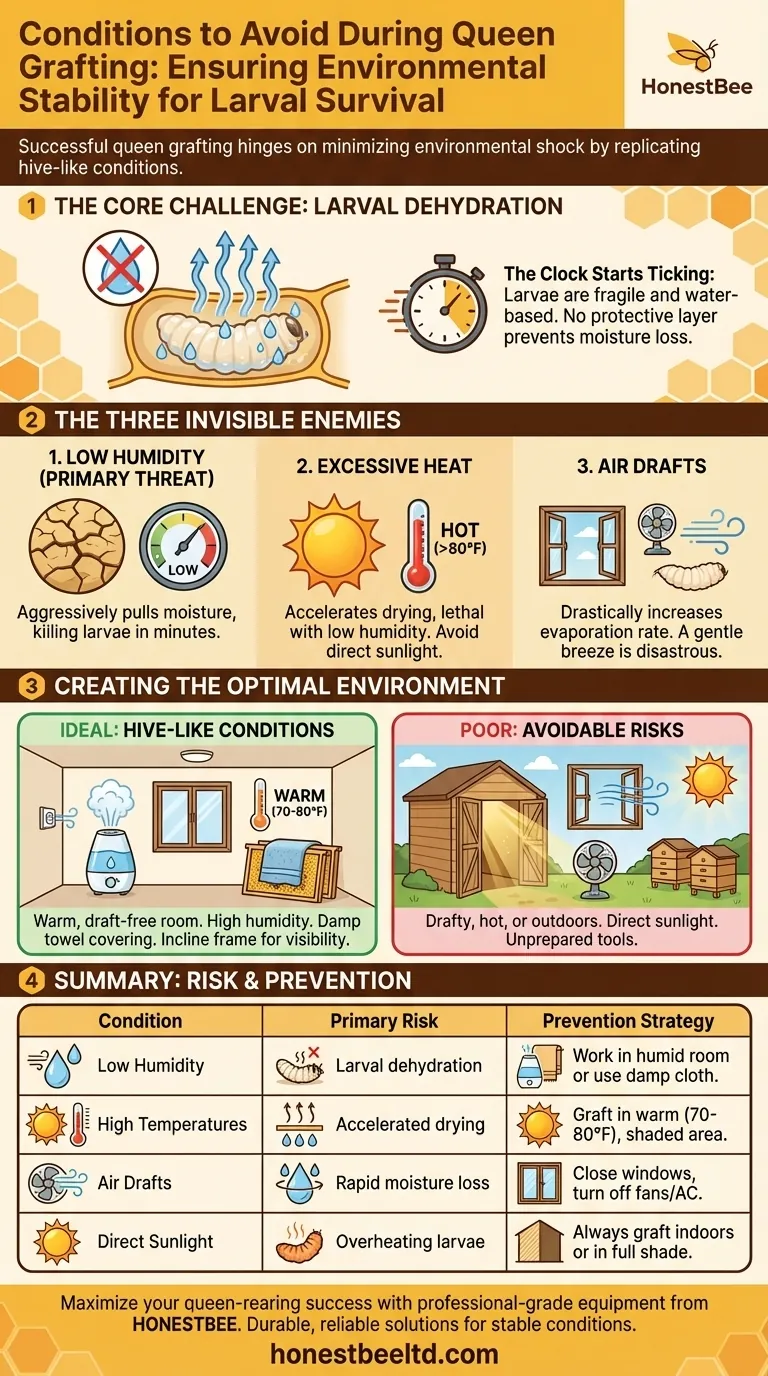Successful queen grafting hinges on environmental stability. The most critical conditions to avoid are excessive heat, low humidity, and any air movement or drafts. These factors can rapidly dehydrate and kill the delicate larvae you are transferring, leading to low acceptance rates and failed queen cells.
Grafting removes a larva from the hive's perfectly regulated nursery. Your primary objective is to minimize this environmental shock by replicating hive-like conditions—high humidity and stable warmth—for the brief time the larva is exposed.

The Core Challenge: Preventing Larval Dehydration
A bee larva is extremely fragile and composed mostly of water. It has no protective outer layer to prevent moisture loss. When you remove it from its cell, the clock starts ticking.
The Danger of Low Humidity
The single greatest threat to a grafted larva is dehydration. An environment with low humidity will aggressively pull moisture from the larva's body, killing it in minutes. This is the primary reason grafts fail.
The Impact of High Temperatures
Very hot weather dramatically accelerates the process of dehydration. While a warm room is beneficial, excessive heat works with low humidity to create a lethal combination for exposed larvae.
Why Drafts are the Invisible Enemy
Even a gentle breeze from an open window, a fan, or an air conditioning vent is disastrous. Air movement across the larva's surface drastically increases the rate of evaporation, effectively drying it out much faster than still air would.
Creating an Optimal Grafting Environment
Your goal is to create a small pocket of controlled air that mimics the conditions inside a brood cell.
Replicating Hive Conditions
The ideal environment is a warm, draft-free room with high humidity. Grafting in the very early morning can help you take advantage of cooler temperatures and naturally higher humidity.
To artificially increase humidity, you can work near a humidifier or place a damp towel over the donor frame and the cell bars you are not actively working on.
Eliminating Air Movement
Choose your grafting location carefully. Close all windows and doors. Turn off any fans, air conditioners, or heaters that create airflow. A calm, still room is non-negotiable.
Improving Your Workspace and Speed
For better visibility into the brood cells, place the donor frame on an incline. This, combined with a good headlamp, prevents you from damaging larvae. Work quickly, but do not rush. The less time each larva spends exposed to the open air, the higher its chance of survival.
Common Pitfalls to Avoid
Success often comes from avoiding simple mistakes that have an outsized impact on your results.
Confusing "Warm" with "Hot"
"Warm" means a comfortable room temperature, roughly 70-80°F (21-27°C). "Hot," such as the inside of a car or a shed in the sun, will cook the larvae. Never graft in direct sunlight.
Grafting in the Apiary
While convenient, grafting outdoors in the bee yard is extremely risky. You have almost no control over temperature, humidity, or wind. For predictable results, always bring the donor frame to a controlled indoor space.
Being Unprepared
Have all your tools laid out and ready before you bring the donor frame inside. Fumbling for a grafting tool or cell cups while the larvae are exposed is a common and preventable error that reduces success rates.
Matching Your Method to Your Conditions
Choose your approach based on the environment you can realistically create.
- If your primary focus is convenience and you must work outdoors: Graft only on a calm, overcast, and humid morning, and keep a damp cloth over the parts of the frame you aren't using.
- If your primary focus is achieving the highest possible success rate: Always move the process indoors to a warm, still room with a source of humidity.
- If you are struggling with damaged larvae: Focus on your technique and visibility by using a headlamp and propping the frame at an angle to ensure clean transfers.
By mastering the micro-environment, you transform grafting from a game of chance into a repeatable, reliable skill.
Summary Table:
| Condition to Avoid | Primary Risk | Key Prevention Strategy |
|---|---|---|
| Low Humidity | Larval dehydration | Work in a humid room or use a damp cloth |
| High Temperatures | Accelerated drying | Graft in a warm (70-80°F), shaded area |
| Air Drafts | Rapid moisture loss | Close windows, turn off fans/AC |
| Direct Sunlight | Overheating larvae | Always graft indoors or in full shade |
Maximize your queen-rearing success with professional-grade equipment from HONESTBEE. Whether you're a commercial apiary or a beekeeping equipment distributor, our wholesale-focused supplies are designed to help you create the stable, hive-like conditions essential for high grafting acceptance rates. Contact our experts today to discuss your needs and get durable, reliable beekeeping solutions delivered directly to your operation.
Visual Guide

Related Products
- Black 2 Pack Beekeeper Queen Grafting Tool for Bee Queen Larva Transferring Needle
- Plastic Chinese Queen Grafting Tool for Bee Queen Rearing
- No Grafting Queen Rearing Kit: System for Royal Jelly Production and Queen Rearing
- Professional 3-Bar Frame Grip with Integrated Hive Tool
- HONESTBEE Advanced Ergonomic Stainless Steel Hive Tool for Beekeeping
People Also Ask
- What is the purpose of grafting in queen bee production? Scale Your Apiary with Superior Genetics
- When do queens emerge after grafting? Master the 12-Day Critical Window
- What is the grafting method for raising queen bees? Master Genetic Control for Your Apiary
- What is the grafting method of queen rearing? Master Controlled Queen Production for Your Apiary
- How should the selected brood frame be prepared for grafting? A Step-by-Step Guide to Protect Larval Viability



















